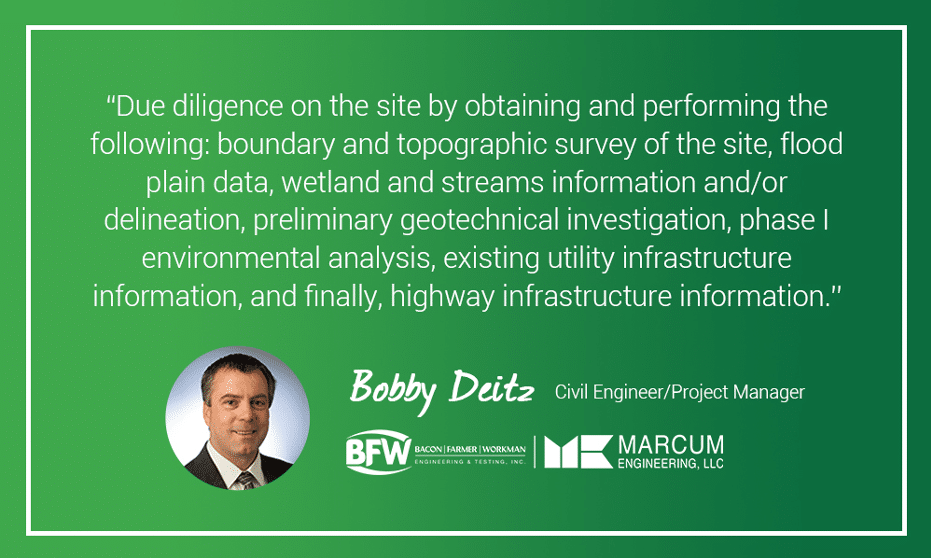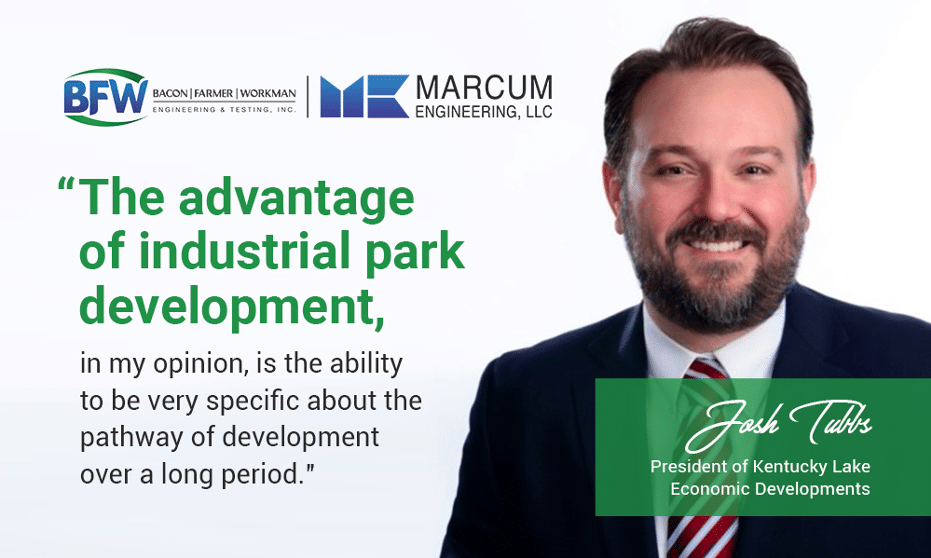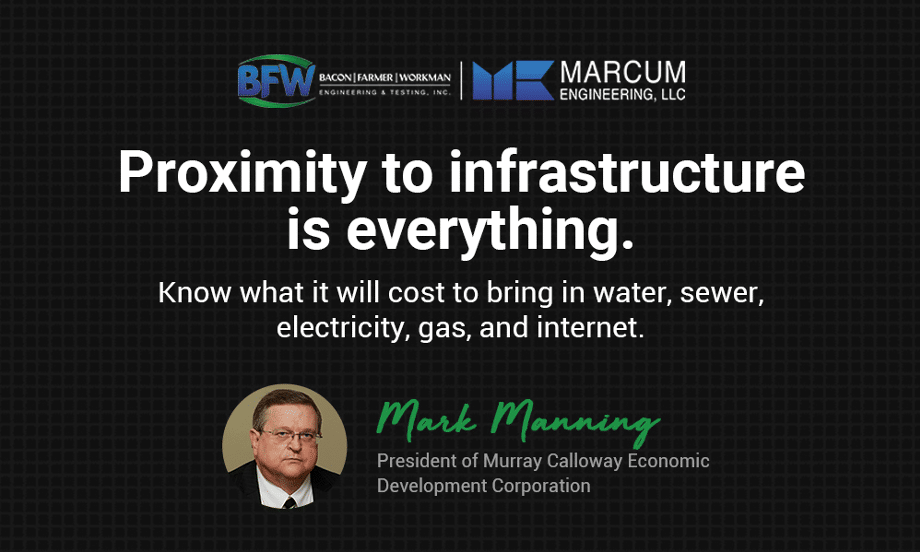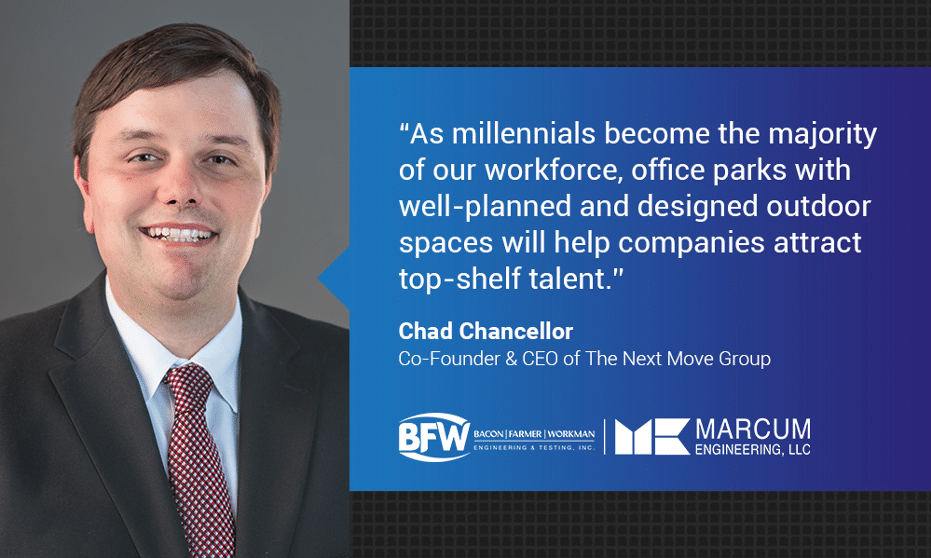Thorough engineering is all about creating and sustaining ecosystems at every level. To put it another way, a good design has harmony across every component. This is easily shown with the engineering of both industrial parks and office parks. While the two spaces host different types of businesses, the parks themselves have foundational similarities. Namely, the design must work in conjunction with the space’s function. To simplify it further, the park can’t get in the way of the day-to-day business of its tenants, but it must still be an attractive, efficient, and useful space.
What is the Difference Between an Industrial Park and Office Park?
The first office park was conceptualized in the 1950s to move potential businesses out of the costlier city centers and into suburbia, where it’s both cheaper to secure land and to build. Office parks are also advantageous because they can be built near highways and public transportation to make commuting easier. The office park broke ground in the 1950s, relieving commuter congestion into and out of major cities and giving families more freedom in where they lived.
On the other hand, the industrial park can be seen as a “heavyweight” version of the office park concept, but they share similar functions. Industrial Parks move a business out of the confined and rigid space of a city to its outskirts, where you can pick cheaper land that best accommodates your specific needs, whether they are industrial or economic. If you were to look at both parks side-by-side, they appear very different. However, at a conceptual level, they’re built with similar principles in mind—convenience, flexibility, and the freedom to build an ecosystem catered to real-world needs.
Analytics, Precision, and Collaboration Start from the Beginning
Bobby Deitz, Civil Engineer/Project Manager, is one of our leads in the industrial and office parks sector. During the early stages, his job involves working with EDC executives to analyze the park’s and the site’s requirements.
“At the start, BFW/Marcum performs something we call due diligence on the site by obtaining and performing the following: boundary and topographic survey of the site, flood plain data, wetland and streams information and/or delineation, preliminary geotechnical investigation, phase I environmental analysis, existing utility infrastructure information, and finally, highway infrastructure information.”
“Following that, we would prepare a preliminary layout of the park in regards to the main entrances and how to locate them concerning any existing roadways, utilities, and lots.”
One of our collaborators, Josh Tubbs, President of Kentucky Lake Economic Development, expands on the need for the local community’s support during this early stage.
“You are going to need support from the public and private sectors as well as community members when designing these spaces. This process requires an educational component that offers some level of transparency in the reasoning behind the development.”
“Beyond earning the goodwill of the community, you must know what your target market will be before your team makes a decision.”
Josh brings up a great point. Industrial and office parks, like all ecosystems, must be built to thrive. Understanding who your tenants will be, what their needs are, and how to surpass their expectations are all important parts of the process. With that process comes a distinct advantage, which Josh explains.
“The advantage of industrial park development, in my opinion, is the ability to be very specific about the pathway of development over a long period.”
Industrial Parks Let You Plan Your Success Before Any Ground is Broken
Renting a space, as a manufacturer, often means compromise. Occupying an existing warehouse means creating a workflow around the existing features of a building, which often results in reduced productivity. However, with an industrial park, you can make every consideration that would increase business efficiency.
Mark Manning, another frequent collaborator and President of Murray Calloway Economic Development Corporation, understands this benefit perhaps more than anyone else in the state of Kentucky.
“I have several items I consider when planning an industrial park: The first consideration is what kind of park are you looking at? Will it be heavy industrial or light to medium? What size can you reasonably afford? If it’s heavy, the park needs to be near large utilities as well as have rail access. If possible, the park should also be near a port. A heavy park will not be as attractive as one for light to medium manufacturing. With that reality, you need to think about what is nearby (houses, schools, churches, etc.). The same things apply to light to medium industrial parks, but efforts need to be made to ensure that the park is as attractive as it is function—you have more wiggle room with these kinds of parks.”
“Secondly, proximity to infrastructure is everything. It does no good to have a beautiful piece of property outside the floodplain if it is not close to good transportation (preferably interstate or a limited access, 4-lane highway). You also have to know what it will cost to bring in water, sewer, electricity, gas, and internet. This can quickly eliminate some sites if the cost is prohibitive. It helps to find space where you have a reasonable chance of being able to add land in the future.”
“You must conduct wetlands delineation, soil borings, and at least a phase I environmental analysis. Assuming all of that is good, you will want to do further examinations for endangered species and archaeological surveys.”
“Of course, all of these factors need to be done methodically with a good engineering firm that you trust being an integral part of the process.”
Creating an Attractive Space is the Key to Workforce Retention
Designing an office park is quite similar. While you may not need as much consideration for the things that make an industrial business move efficiently, you still can cultivate an attractive, highly functional space for tenants.
Chad Chancellor, Co-Founder & CEO of The Next Move Group, is someone we often work with. As an expert in executive site selection, he has plenty to share about the most important tenets to building a healthy and sustainable office park.
“Well designed office parks provide amenities that millennials and technology workers typically desire, which helps companies locating in the park attract talent.”
“These amenities include green space with trees, walking paths, dog parks, water features, bike paths, hangout areas (such as gazebos and/or water features), DISC golf courses, etc. As millennials become the majority of our workforce, office parks with well-planned and designed outdoor spaces will help companies attract top-shelf talent.”
Happy workers and solid retention aren’t only helping the company, they also serve to bolster the local economy directly as well as ripple out into the national and global economy. Office parks help us rethink how to serve our workforce and make the implementation of those findings much easier.
The Future of EDC is About Building on What Already Works
Chad also has an idea about how the future of the industrial park will look. He suspects that many of the ideas already found in office parks will be incorporated into industrial parks.
“We predict, in the future, industrial parks will incorporate many of the same ideas good office parks are already incorporating when it comes to outdoor space. Labor will continue to be harder to find, meaning employees will want to work in good looking spaces with amenities they can access during breaks.”
“More and more industrial buildings will include larger windows to let in more natural light with glass facades. This both saves money on lighting costs and creates a more attractive work environment for employees.”
Mark Manning is not one to mince words when speaking on the subject of the future of the industrial park; he had this to say, “The future of industrial parks is pretty simple. If you have everything a client needs, you will be successful. The days of getting a cheap piece of property in the floodplain are over. Today, clients want a modern, fully served property within a controlled environment. Nothing less will do.”
While efficiency can sometimes be used to squeeze the last bit of productivity out of a tired or strained workforce, modern sensibilities show that sustained, mutually-productive efficiency is achieved through a happy and healthy workforce. Contemporary industrial and office parks find that harmony much more easily. We’re happy to be involved with these great minds to conceptualize and implement the thoughtful approaches to the contemporary industrial and office park.





Recent Comments